Sodexo Pledges $150,000 for CIA Scholarships and Creates Externship
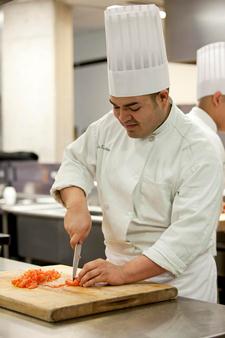 Sodexo, the leader in Quality of Daily Life Solutions, has pledged a gift of $150,000 toward scholarships at The Culinary Institute of America (CIA), San Antonio. The scholarships will provide additional educational opportunities for Hispanic students who aspire to be the foodservice leaders of tomorrow. Sodexo is also establishing a new paid externship for students at the college's San Antonio campus.
Sodexo, the leader in Quality of Daily Life Solutions, has pledged a gift of $150,000 toward scholarships at The Culinary Institute of America (CIA), San Antonio. The scholarships will provide additional educational opportunities for Hispanic students who aspire to be the foodservice leaders of tomorrow. Sodexo is also establishing a new paid externship for students at the college's San Antonio campus.
The newly established Sodexo Scholarship Fund will provide two scholarships a year for the next three years for qualified Hispanic students. One scholarship is for new students who enroll at the CIA San Antonio. The other will help current students demonstrating financial need, who maintain a minimum grade point average of 3.0. In addition, Sodexo is creating an externship beginning in 2012, for CIA San Antonio students to complete the required field experience to earn their associate degrees.
"Sodexo is proud to be able to assist talented individuals who otherwise might not be able to access the world-class education The Culinary Institute of America provides," says Lorna Donatone, chief operating officer and education president for Sodexo. "This is a win-win for the students and Sodexo, because our company will now have a wider and more diverse group of talented CIA graduates from which to recruit our future leaders."
Sodexo has a long relationship with the CIA, including participating in the college's quarterly career fairs to hire students for externships and management positions throughout the company. As part of this gift, CIA Career Services will work with Sodexo to create a customized employee recruitment plan.
Photo: Hispanic students have greater opportunities for career advancement in the foodservice industry with the help of Sodexo Scholarships at The Culinary Institute of America, San Antonio. Courtesy of CIA/Keith Ferris.

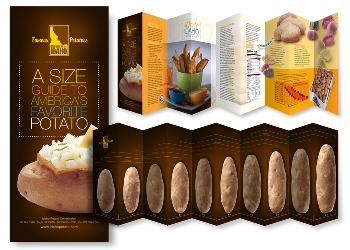 The Idaho Potato Commission (IPC) is offering a unique, information-packed guide designed to make purchasing potatoes a walk in the park. Everything from storage to performance to a special section on sizing and packaging is covered. A Size Guide to America’s Favorite Potatoes also includes 10 actual photos of potatoes ranging in size from 5.3 to 16 ounces, which helps the operator order with ease. Take the guesswork out of ordering spuds with useful tips from the experts.
The Idaho Potato Commission (IPC) is offering a unique, information-packed guide designed to make purchasing potatoes a walk in the park. Everything from storage to performance to a special section on sizing and packaging is covered. A Size Guide to America’s Favorite Potatoes also includes 10 actual photos of potatoes ranging in size from 5.3 to 16 ounces, which helps the operator order with ease. Take the guesswork out of ordering spuds with useful tips from the experts.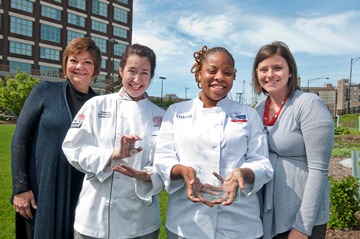 Olson Communications, a full-service agency that specializes in delivering innovative marketing-communication strategy to its portfolio of select food-industry clients, announces the winning recipients of its fourth-annual Chefs of Tomorrow™ grant program for culinary educators.
Olson Communications, a full-service agency that specializes in delivering innovative marketing-communication strategy to its portfolio of select food-industry clients, announces the winning recipients of its fourth-annual Chefs of Tomorrow™ grant program for culinary educators. Kendall College School of Culinary Arts student Uyen (Nina) Nguyen won the Michelin Scholarship for Culinary Excellence. The scholarship program is sponsored by Michelin, publisher of the world-renowned restaurant rating systems and guide. Nguyen received a $5,000 culinary scholarship and a stage at her choice of the chef judges’ establishments. The student competition, hosted by Kendall College on May 23, was evaluated by top Chicago chefs, whose restaurants are featured in The MICHELIN Guide Chicago 2011, as well as by surprise celebrity chef Eric Ripert from New York City.
Kendall College School of Culinary Arts student Uyen (Nina) Nguyen won the Michelin Scholarship for Culinary Excellence. The scholarship program is sponsored by Michelin, publisher of the world-renowned restaurant rating systems and guide. Nguyen received a $5,000 culinary scholarship and a stage at her choice of the chef judges’ establishments. The student competition, hosted by Kendall College on May 23, was evaluated by top Chicago chefs, whose restaurants are featured in The MICHELIN Guide Chicago 2011, as well as by surprise celebrity chef Eric Ripert from New York City.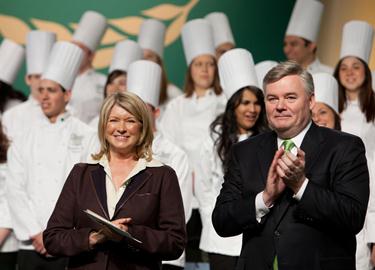 America's premier lifestyle authority advised graduates of The Culinary Institute of America (CIA) that generosity and hard work will be the secret to their success. Martha Stewart delivered the commencement address at the CIA on Friday, April 15, 2011. During the ceremonies, CIA President Dr. Tim Ryan, CMC, bestowed the college's Master of the Aesthetics of Gastronomy award upon Stewart and presented her with a personalized CIA chef's jacket.
America's premier lifestyle authority advised graduates of The Culinary Institute of America (CIA) that generosity and hard work will be the secret to their success. Martha Stewart delivered the commencement address at the CIA on Friday, April 15, 2011. During the ceremonies, CIA President Dr. Tim Ryan, CMC, bestowed the college's Master of the Aesthetics of Gastronomy award upon Stewart and presented her with a personalized CIA chef's jacket.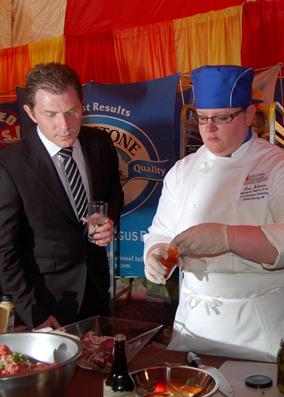 On May 5 at the second-annual Taste of Derby, three Sullivan University students participated in a burger competition sponsored by Creekstone Farms. Chef judges Bobby Flay, Kent Rathbun and Jo-Jo Doyle awarded Kara Schnaus the $5,000 scholarship prize for her Kara’s B-5 Burger. The original recipe featured Creekstone Farms Black Angus ground chuck seasoned with garlic and jalapeño, spicy mayonnaise, caramelized onions and Swiss cheese served on an onion poppy-seed bun.
On May 5 at the second-annual Taste of Derby, three Sullivan University students participated in a burger competition sponsored by Creekstone Farms. Chef judges Bobby Flay, Kent Rathbun and Jo-Jo Doyle awarded Kara Schnaus the $5,000 scholarship prize for her Kara’s B-5 Burger. The original recipe featured Creekstone Farms Black Angus ground chuck seasoned with garlic and jalapeño, spicy mayonnaise, caramelized onions and Swiss cheese served on an onion poppy-seed bun.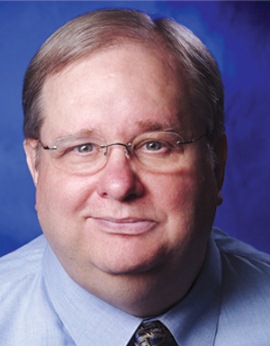 Despite the challenges, we take joy in producing them.
Despite the challenges, we take joy in producing them. Foodchannel.com
Foodchannel.com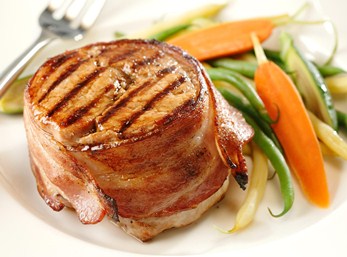 New USDA guidelines lower pork cooking temperature by 15 degrees Fahrenheit, to the delight of chefs and consumers throughout America.
New USDA guidelines lower pork cooking temperature by 15 degrees Fahrenheit, to the delight of chefs and consumers throughout America.